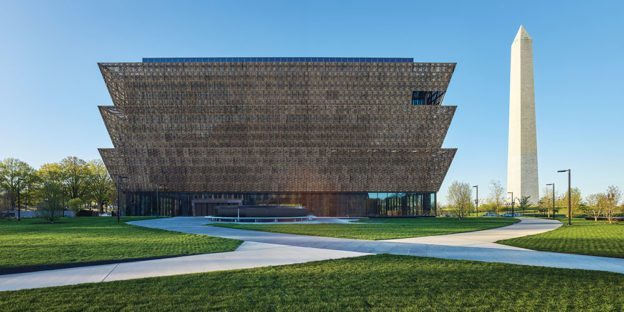My eye is immediately drawn to the word “travel” mixed in with a shifting collage of images on an interactive table. I tap and drag the word towards me to see a black-and-white image of African-American author James Baldwin pondering a cityscape in Istanbul.
I’m at the Smithsonian’s National Museum of African American History and Culture specifically seeking out artifacts that speak to African-American travel throughout American history, but it occurs to me that maybe I’m being too literal. The entire museum is dedicated to travel, really.
Its mission is to document “A People’s Journey,” an American journey that takes place across oceans, land and time; a journey that is, at times, harrowing and traumatic, and at others, joyful and triumphant.

“What we wanted was to craft a museum that had a certain tension, a tension between moments where you ponder the pain of slavery and segregation and second class citizenship, but you also find that joy,” says NMAAHC Director Lonnie G. Bunch III to our group gathered to preview the museum.
Bunch and his staff of 200 have achieved this and more through the exhibition of nearly 3,000 objects, 12 exhibits, 13 interactives and 183 videos housed on five floors throughout the stunning 85,000 square foot space.

But it’s the “The Power of Place” exhibit that I can’t seem to leave. As a traveler, a sense of place is always on my mind. Does this place feel like home? Where to next? I sense a connection as I look at a photo of nomadic writer James Baldwin and read about his need to find a place of silence and privacy. His well-stamped passport is here in the museum, too, as proof of his constant search.
The exhibit traces nomadic movements of other African Americans across the country to the places where they settled and thrived, going west to build entire towns in places like Indiana, Ohio and Wisconsin, and creating their own inns and vacation resorts in places like Oak Bluffs in Martha’s Vineyard, Mass., Barrow’s Landing in Spokane, Wa., and Highland Beach in Annapolis, Md.


Special travel guides may have led them to some of these recreational safe havens, like the Green Book, listing gas stations, rooming houses and eateries welcoming to African Americans, as well as another guide with the tagline, “Vacation and Recreation Without Humiliation.” Both are featured in the collection.
I’d heard of some of these destinations and even visited a few, but seeing them represented in a special place on the National Mall put them in a new and different context. It forces me to think about how freely I move about the world. These places were safe havens during Jim Crow when barriers held firm and access was denied; now they are being honored.
The cornerstone of the museum, a segregated train car in the History Galleries that was lowered in place before the museum formed around it, is the physical representation of those barriers to access.

“A big part of the importance of this museum is being able to tell stories that will last for generations,” says Michèle Gates Moresi, Curator of Collections at the museum. “In the United States we no longer have segregation – there are situations that we are continuing to deal with, very challenging ones – but having separate bathrooms and separate dining rooms and separate railcars, where you are separated and told you don’t belong, doesn’t exist any more. We have to help people remember that something as mundane as a train ride can evoke this time by physically having this here.”

As it turns out, the railcar is also the perfect representation for how things have landed in the museum for national posterity’s sake.
“We were initially looking at Pullman cars and looking for a sleeper car because we were thinking that we would talk about the sleeping car porters in particular,” Moresi explains. But an offer from Pete Claussen, founder of the Gulf & Oil Railway and longtime supporter of the Smithsonian, was too good to pass up.
“He had this railcar and we were like, ‘Well, do you now?’” Moresi says. “He thought it would be interesting because it was a segregated car. So Lonnie and I went down to the Tennessee Valley Railway Museum where it was being stored … it was kind of a rusty circumstance at the time.”
In stark contrast to the segregated rail car and four floors up in the “Musical Crossroads” exhibit is Chuck Berry’s shiny red Cadillac convertible; a symbol of what it means to feel free on the open road “with no particular place to go.”

This is the joy that Bunch was talking about earlier. Steps away from the car is the spaceship featured in the concerts of the futuristic funk band Parliament-Funkadelic, looking like it’s set to blast off. It’s this mix of pop culture and history that the museum was aiming to achieve to tell the whole story and move it forward.
“In some ways African-American history and culture is the quintessential American story,” Bunch says. “This museum points us toward a future where we are freer from discrimination, freer from political concerns that limit people.”

The century-long journey to even found a museum dedicated to this American story has to be included in the narrative too. Moresi is proud to have been a part of the telling.
“It’s that much more poignant in that [African Americans] were here since the founding, since the colonies; and the issue of who is free and who is not, and who has privileges and who doesn’t has been at the core of the United States and this democracy, and an issue we still wrestle with today,” Moresi says. “So that’s why we think this has meaning for everybody that comes through here. That’s a journey that everyone can appreciate.”
This article was written by Robin Bennefield and was originally published by our partner, Marriott TRAVELER.








